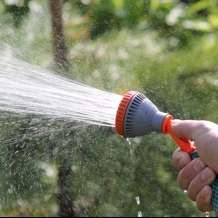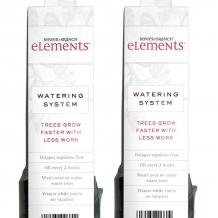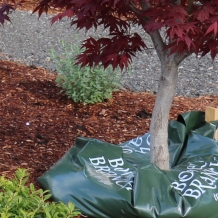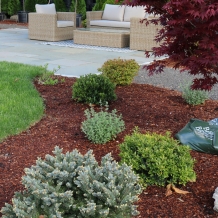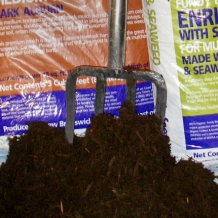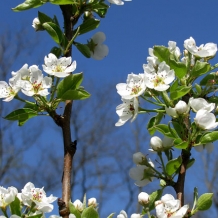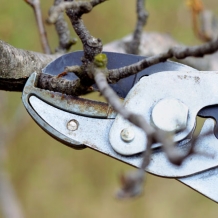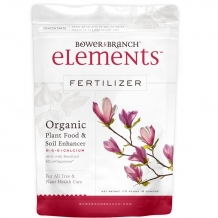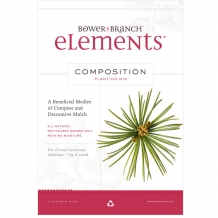Care & Maintenance
Watering
Proper watering is critical to the survival of newly planted trees and shrubs. Watering requirements will vary greatly given the plant species, site conditions, soil conditions, and seasonal changes.
The specific physical, chemical and biological properties of soil will greatly dictate the required amount of water. The soil structure, the arrangement of soil particles (sand, silt & clay), and the soil texture (fineness or coarseness of a soil), will dictate varying degrees of water infiltration and air space. Compacted soil restricts root growth, reduces water availability and infiltration, and limits the movement of gases in the root zone. If, for example, the ground is saturated for too long of a period of time, the degree of gas exchange will decrease. Therefore, excess moisture is more likely to suffocate the root system. If, on the other hand, there is too little moisture in the root zone, the plant may ultimately desiccate (dry out) and die.
The appropriate amount of water for a particular plant over a specific period of time varies greatly. It is almost impossible to put an exact number on a range of plants planted in a range of conditions. The type of plant, existing weather conditions, type of soil, and level of light all contribute the establishment, growth and survivability of a plant. There is also a high level of uncertainty involving weather patterns over a course of time. For this reason, we suggest monitoring your plants daily for watering requirements. On rare occasions it may be necessary to water perennials and annuals more than once in a day. Not only is it important to monitor the frequency of watering, it is also necessary to monitor the entire root zone of the plant. If only a portion of the root zone receives moisture, then only a portion of the plant may survive. Plants are living organisms and although their root systems are most active in the spring and fall it is vital to watch their progression 365 days a year.
Generally speaking, above ground sprinkler systems will not provide adequate moisture during a tree or shrub's first few growing seasons. A deep and gradual soaking of the root zone is preferable. The roots of the plant absorb nutrients along with the moisture that they take in. It is therefore imperative to water the root zone of the plant, soaking the surrounding soil, not the leaves and branches of the plant.
General Rules of Thumb
Established Trees & Shrubs: As a general rule, the majority of established plants generally require 1 inch or more of water per week. If rainfall is less than 1 inch per week, additional water may be necessary. The more established a plant is in the ground, the less watering it will typically require. A plant that was transplanted within the last year or two will require more water than a plant that has been established for more than two years and that has a more established root system.
Newly Planted Trees & Shrubs: As a general rule, within the first 3 months following initial planting, trees and shrubs should be adequately watered two to three times a week. Less watering may be required if the planting site is more shaded. After the first 3 months, adequately watering once to twice a week may be sufficient.
New & Established Perennials & Annuals: Watering requirements of perennials and annuals vary so greatly that we suggest monitoring their water habits daily. Watering requirements will vary greatly given the plant species, site conditions, soil conditions, and seasonal changes.
Trees require a slower soaking of the root zone to initiate a deeper infiltration into a larger area of the surrounding soil. Shrubs typically require slow, yet more frequent gentle soakings of the root zone. Shrubs are subjected to drying out much faster because of their smaller root systems and closer proximity to the ground surface where evaporation is more common. Perennials and annuals tend to have very high water content and are subject to both evaporation and transpiration much more so than trees and shrubs. For that reason, we recommend watering new and established perennials more frequently than your standard tree or shrub.
Application
Wildwood recommends using a hose as a best watering practice. Slow gentle soakings work best. Wildwood does not recommend the sole use of above ground sprinklers for plantings. In fact, the use of above ground sprinklers can have a negative effect. Frequent watering on the leaves of plants or on the ground surface can cause fungal diseases to develop. Soaker hoses and drip irrigation can be more effective than the use of above ground sprinklers if used correctly. One word of caution: if a soaker hose or drip irrigation system is being used, please be sure that the system is set up to irrigate the entire root zone of the plant, not just a portion of it.
Wildwood recommends the use of a Bower and Branch™ Watering Element as a preferred way to irrigate new trees and shrubs. This system includes a water resevoir and drip emitters that slowly release water to the plant over an extended period of time. Depending on the weather and heat conditions, a Bower and Branch™ Watering Element may only need to be refilled once every 10 - 14 days.
Summary
Due to varying site conditions, soil conditions, and environmental conditions, the amount of water that should be added to a newly planted tree, shrub, annual, or perennial can vary immensely. In addition, different plant species require varying amounts of water. It is important that you are aware of the individual watering requirements for each given species inyour landscape. The key is to create an appropriate level of adequate moisture in the soil, and to avoid excessive water accumulation. Too much water for prolonged period of time may “drown” or suffocate the roots.
Mulching
It is appropriate to lightly top dress beds with organic mulch once every year or even every other year. When doing so, it is important to avoid the creation of a “mulch volcano” around your plants. “Volcanoes” of mulch are the result of an excessive build up of mulch around the trunk of trees and shrubs. This excessive layer of mulch restricts the oxygen and water available to the roots and can ultimately lead to root or trunk rot. The mulch volcano also often promotes the development of a secondary root system encircling the main stem, ultimately strangling the plant. To avoid these kinds of problems, it is advisable to check the level of decay/breakdown of mulch on an annual basis and remove old mulch from around the trunk/stem of the plant if necessary. It is also advisable to use an organic mulch, such as Coast of Maine® mulch, which adds a beneficial source of nutrients back into the soil as it breaks down, therefore promoting healthier, fuller plants.
Pruning
Timing
Pruning when trees are dormant can minimize the risk of pest problems associated with wound entry and can allow plants to take advantage of the full growing season by closing and compartmentalizing wounds. If pruning takes place during or after the initial flush of growth in the spring, overall plant growth can be reduced. Plants exert a great deal of stored energy to produce foliage and any removal of live stems at this time can stress the plant.
Flowering can be prevented or enhanced by pruning at the appropriate time of the year. Landscape plants that bloom on current season’s growth are best in pruned in late winter, prior to leaf emergence, or in the summer or early fall right after bloom occurs. Plants that bloom on last season’s wood, including many fruit trees, should be pruned just after bloom. Routine pruning of dead, weak or diseased stems or branches can be accomplished at almost any time of the year with little negative impact.
Cuts
All pruning cuts should be clean and made at the proper location. The surface should be left smooth with no torn bark or jagged edges. Typically, the preferred place to make a cut is back to the parent branch or trunk, just to the outside of the branch collar. Cutting outside the branch collar does not damage trunk tissue. At times, it may be necessary to reduce the length of a limb by cutting back to a lateral branch. Pruning cuts to reduce the length of a branch should bisect the angle between the branch bark ridge and an imaginary line perpendicular to the stem or branch being removed.
Fertilizing
Use
Plants require specific essential elements to grow and function. Essential elements are chemical elements that are involved in the metabolism of the plant and are necessary to complete the plants lifecycle. Plants in a given landscape may be growing in soils that do not contain sufficient available elements for satisfactory growth and development. In residential and commercial landscapes it is often necessary to fertilize or adjust the soil pH to increase available elements. Trees require 17 essential elements. Each element has its own specific role in a plant. Certain plants typically require certain supplemental macronutrients and micronutrients more than other plants. Of all 17 essential elements, three macroelements are most beneficial to plants. A complete fertilizer is one that contains nitrogen, phosphate and potash, always listed in the same order and is expressed as a percentage of weight. Nitrogen emphasizes green color and dense foliage. Phosphorus emphasizes development of flowers, fruits or vegetables. Potassium emphasizes overall plant hardiness and the plants ability to withstand stress.
Fertilizers are available in organic or inorganic forms. Inorganic forms release their elements relatively quickly when dissolved in water. Organic fertilizers do not release their elements as quickly; however, they do not leach as readily from the soil. The rate of availability is more uniform. Wildwood recommends using only slow-release fertilizers, which release elements over an extended period of time. Slow-release fertilizers reduce the amount of fertilizer that may be leached and also reduce salt burn issues.
Rate
The rate at which fertilizer should be applied depends on the species, age, health, site conditions, the method of application and the form of fertilizer. Please use as directed by the manufacturer.
Timing
Metabolic demand and uptake is lowest in the dormant season. The most limiting factor in fertilizer uptake is moisture availability. The frequency of application depends greatly on the species and soil conditions, among other things. In sandy soils, such as those that are more common in Rhode Island, smaller amounts of fertilizer may need to be applied more frequently because of the greater possibility of leaching. Fertilizer uptake is highest during the periods of most active root growth; spring and fall. If quick-release fertilizers are used, they are most effective in spring or fall. Slow-release fertilizers are effective as long as the soil moisture is adequate and the ground is not frozen.
We Recommend
Wildwood recommends using Bower and Branch Elements® Fertilizers at planting time and for long term maintenance of your landscape plants.
